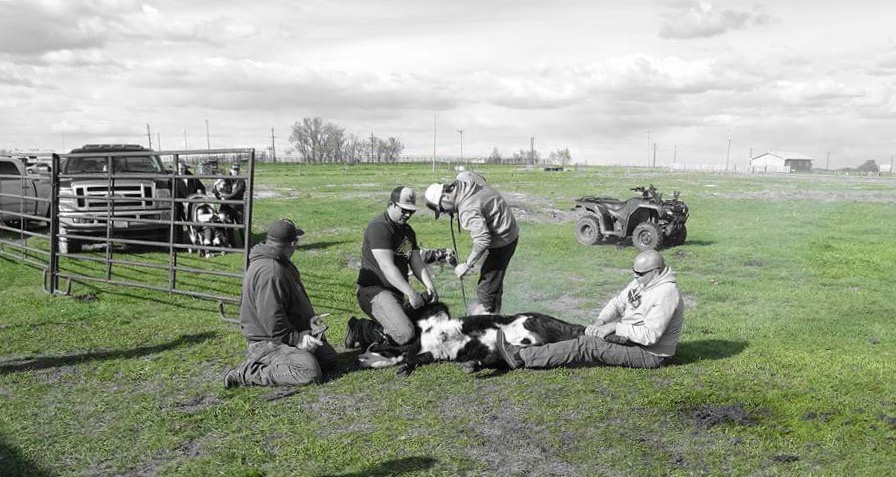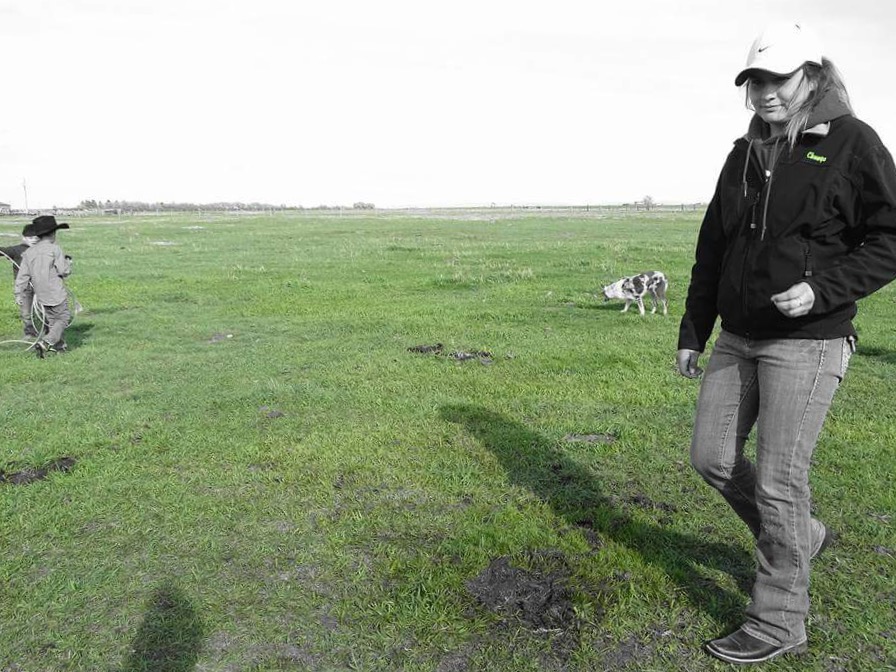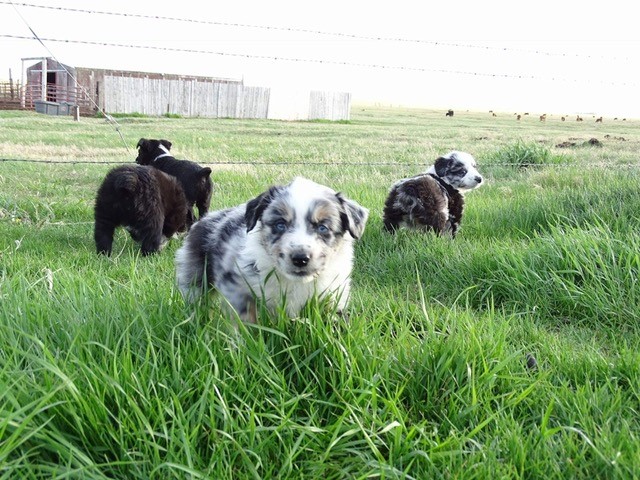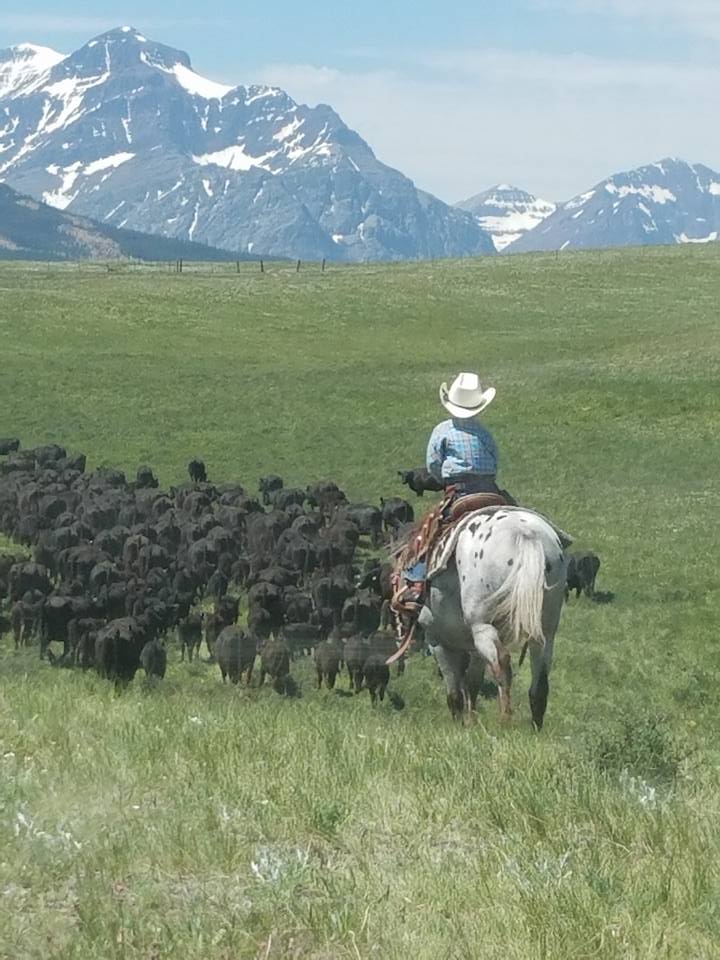Agriculture Sector in the Blackfeet Climate Change Adaptation Plan

Branding in Indian Country. Photo by Mya Davis.
The Agriculture chapter of the 2018 Blackfeet Climate Change Adaptation Plan (BCCAP) is one of eight chapters created for the first formal, multi-sector climate change adaptation planning effort in the Blackfeet Nation, following the process described here. The Agriculture Chapter was developed through meetings and correspondence with the Blackfeet Agriculture Resource Management Planning management team. The first two sections, observed impacts and expected impacts, are sets of working hypotheses about climate change that are based on day-to-day observations and/or interpretations of climate change literature (e.g. the Montana Climate Assessment). These hypotheses were formed for the purposes of assessing climate change vulnerability and then strategizing adaptation goals and actions. This and other sections of the plan will be revisited and updated periodically as action items are implemented and adaptation efforts produce insights for future planning.
The goal of the Agriculture Sector is to focus on planning for irrigated land, grain production (especially wheat and barley), livestock production (horses and cattle, plus forage quality and quantity), seasonal crops, pollinators, and potential for fire damage. Agriculture management is currently under the jurisdiction of several departments with current efforts to create an Agriculture Department. The focus area is located across the Blackfeet Nation.

Observed Impacts
Relative to irrigated hay, the productivity of non-irrigated hay is decreasing due to warming temperatures. With increased temperatures, climate change impacts could also extend the growing season; however, non-irrigated hay will also be more susceptible to drought, lowering its production.
Expected Impacts
Most of the impacts described in this section are derived from the Montana Climate Assessment’s description of impacts to the North Central climate division and interpreted with known differences between the broader region and the specific locality of the Blackfeet Reservation. For example, one notable difference is that while small-grain production dominates the agricultural landscape of the North Central climate division, earning it the name of “the Golden Triangle,” cattle production dominates in the Blackfeet Nation. Furthermore, given the absence of climate data and monitoring specific to the Blackfeet Nation, these impacts should be interpreted with an understanding that they have an added layer of uncertainty.
Impacts to Irrigated Land

Climate change is increasing the length of the growing season. However, day length and photoperiod will remain constant, and drought will likely increase, most likely curtailing many of the benefits brought by a longer season. Evapo-transpiration stress from rising temperatures and drought will likely increase farmers’ reliance on irrigation. However, diminishing mountain snowpack will constrain the amount of water available for irrigation and makes its capacity less reliable (particularly effecting hay, sugar beet, malt barley, market garden, and potato production). With an extended growing season, earlier snowmelt will further limit water availability in the latter part of the season. So, while climate change will likely increase irrigation demand, groundwater and natural surface water storage will diminish.
Impacts to Grain Production
Crop production trends are influenced by a variety of economic factors, making it difficult to pinpoint climate as a single source of changing production. Climate impacts combine with changing global commodity prices, changes in crop selection, government subsidies, crop insurance programs, improved cultivars, and specialized marketing channels to influence farm yields and incomes. However, increasingly volatile weather from climate change will increase market uncertainty, locally and globally, creating costs for crop selection and crop quality – costs that will be borne by producers and marketers. Warming temperatures will likely persuade farmers to shift towards winter wheat production, as spring wheat production can suffer from rising temperatures. Economic factors will complicate the shifting ratio of spring to winter wheat and will, along with climate change, likely influence shifts to other crops like corn. Corn and soybean acreage has increased in Montana in response to economic factors and possibly increased growing season length and warming temperatures.
Climate change will likely influence the impact of crop diseases like stripe rust (which infects wheat), wheat streak mosaic virus, leaf spot diseases, and insect and mite-vectored diseases. For example, stripe rust can be more aggressive at higher temperatures, decreasing yield and diminishing crop quality.
Crop pest survival and crop damage are predicted to increase with rising temperatures. The wheat stem sawfly causes more crop loss in winter wheat than in spring wheat, so its impacts may increase as farmers shift to winter wheat crops in response to warming conditions.
Climate change may further reduce crop yields by increasing weeds in some areas. Yellow star thistle and salt cedar are predicted to expand in range, while the ranges of spotted knapweed and downy brome are expected to shift. Weed responses will be variable, however, and leafy spurge is expected to contract. Adding to the complexity of crop and range management is that increased carbon dioxide concentrations may decrease the effectiveness of herbicides. Climate change will also likely alter the effectiveness of biocontrol agents in a range of ways, making them more or less effective, depending on the specific weed and biocontrol agent.
Impacts to Livestock Production
In Montana, a decreasing supply of water for irrigation (see “Impacts to Grain Production” sub-section, above) will likely impact livestock producers who rely on irrigated hay production. Non-local impacts of climate change may impact producers in the Blackfeet Nation by increasing demand for hay exports from Montana. Changes in climate will also impact producers who graze livestock on non-cropped pasture and rangeland (see also Land and Range chapter). Forage quantity may decrease, and quality may degrade as temperatures rise and drought conditions increase in northwest Montana. More specifically, crude protein and digestible organic matter may decline in forage, negatively impacting animal nutrition. Heat stress will increasingly impact livestock as the number of days with temperatures above 90°F increases. Climate is likely to impact disease transmission in livestock, although Montana-specific data are lacking for cattle. Overall, predictions are difficult due to the complex array of factors that impact the livestock industry. For example, most Montana livestock producers ship cattle out of state to feedlots, so climate impacts in other regions will affect their operations. However, if the Blackfeet are successful in their efforts to establish their own meat packing plant, this could benefit beef produces significantly and could be seen as a key adaptation strategy.
Impacts to Pollinators
Climate change has already triggered a decline in some species of pollinators. As temperatures warm, plant and pollinator phenology (the timing of life cycle activity) will likely shift. The shift may occur in such a way that pollinators and plants are not synchronized. Furthermore, as farmers respond to drought conditions and reduced yields, they may expand their farming area, encroaching upon pollinator habitat.
Increased Probability for Fire
A projected net effect of climate change is increased fire severity. Greater fire severity will result from warmer weather and past management policies like forest fire suppression.5 This could directly increase agricultural losses to fire and negatively impacting the health of agricultural workers with prolonged exposure to unhealthy particulate levels from regional fires.
Agriculture Assessment
The location of concern is the entire Blackfeet Nation. At the same time, agriculture management will need to consider local micro-climates and the east-west rain gradient found in the Blackfeet Nation. The timeframe begins now and extends into the future, as some of the expected impacts are already being observed.

Agriculture in Indian Country. Photo by Rikki Ollinger.
Probability of Impacts to Agriculture
There is a high probability of impact. Warmer annual temperatures, increased extremely high temperature days, reduced snow pack, earlier snowmelt, decreasing summer precipitation, and increased frequency and severity of drought are key drivers.
Confidence
High
Potential Consequences of Impacts
Potential consequences are high.
Increased volatility in climate will negatively impact producers and consumers by increasing prices of grain and beef. Potential economic costs include increased prices for agricultural inputs, decreased average yields, and increases in frequency of agricultural losses to extreme weather events.
From an ecological standpoint, attempts to recover declining yields may lead producers to expand areas of cultivation or livestock range, overtaking habitat for pollinators and other types of flora and fauna that inhabit spaces near and within farms. Expanding agricultural areas would require more water, decreasing its availability for ecological functions. Increased applications of herbicides and pesticides could decrease water quality.
Vulnerability:
Exposure
The exposure is high for grain and livestock production.
Sensitivity
Sensitivity is high.
Adaptive Capacity
The adaptive capacity is low, given constraints and complexities of governing fractionated land parcels in the Blackfeet Nation. However, money from the Cobell settlement buy-back program, the passage of the Water Compact, and the current agriculture resource management planning process together create exciting opportunities for building climate resilience in Blackfeet agricultural management.
Vulnerability
Vulnerability is high.
Risk:
Estimated Risk
The estimated risk is high, given that there are both high consequences and high probability.
Priority
Priority is high, given that there is high risk and high vulnerability.

Ranch dogs. Photo by Rikki Ollinger.
Agricultural Adaptation Strategies: Goals and Actions
Responsible Party
The core staff of the Agricultural Resource Management Planning (ARMP) process are currently laying the foundation for a brand-new agriculture department, with the ultimate goal of having the new agriculture department’s staff be responsible for implementing the agricultural adaptation strategies. The primary ARMP planner reports to the Blackfeet Natural Resources Conservation District and the Tribal Business Council.
Purpose (Goals)
1) Promote healthy ecosystems
2) Create an environment where producers can make money
3) Promote specific types of crops based on human nutrition needs
4) Support cropland production in the Blackfeet Nation
5) Support healthy livestock operations
6) Improve land governance
7) Establish monitoring systems for adapting to changes in the environment
8) Develop a comprehensive emergency management plan that takes agriculture into consideration to help take advantage of federal programs and money
Priorities
The priority for agricultural management is high.

Photo by Sadie Harwood.
Preparedness Goals: Strategies and Actions
Goal 1: Promote healthy ecosystems
Strategies:
a) Promote soil health
Actions:
1) Make soil quality part of the appraisal process so that agricultural land value is dependent on the health of the soil
2) Investigate no-till farming to see if there is a methodology that does not use spraying
3) Identify methodologies that will allow us to keep carbon in the ground (e.g. no till farming) – especially, to see if there is a methodology that reduces reliance on spraying, such as cover crops, crop rotation, or plant buffers
4) When appropriate, encourage tillage and no-till practices that promote soil health, innovations in cover-cropping, and/or rotation with pulse and other crops
b) Restore and protect water ways and wetlands
Actions:
1) Restore riparian areas by installing off-site watering troughs
2) Protect existing wetlands habitat
3) Encourage co-existence with beavers to promote riparian area creation and maintenance and increase natural water storage
4) Maintain stream-flows and geomorphology of rivers and streams, with an understanding of natural patterns of fluctuation (e.g. via modification by beavers)
5) Identify areas of natural water storage and look at effects of infrastructure on restoring those areas. Identify wetlands that have been created by current inefficiencies of water infrastructure, since repairing the infrastructure may eliminate the wetlands. Identify places where new wetlands should be created to compensate for repaired infrastructure
6) Identify possible areas for wetlands restoration, including areas where wetlands were removed during creation of current infrastructure
c) Create and protect wildlife habitat
Actions:
1) Promote sage grouse protection on farms and tribal public lands
2) Create designations for permanent land conservation
3) Enhance native pollinator habitat (both floral and nesting resources on natural and managed lands)
d) Utilize sustainable energy for agricultural operations
Actions:
1) Use alternative energy to pump water off-site
e) Assess all resources that are available for tribal producers that will augment larger conservation goals (e.g. financial incentive programs), and assist producers with accessing those resources
f) Change the eligibility requirements with USDA programs so they are aligned with trust land management complexities
Actions:
1) Continue to make recommendations with Senators Tester and Daines
2) Make memorandums of understanding between the USDA and the Department of Interior (via the Bureau of Indian Affairs)
g) Utilize traditional ecological knowledge to augment conservation practices
Actions:
1) Recognize where people fit in the larger ecosystem so that natural processes are better observed and respected
2) Augment the preservation of specific species through the use traditional storytelling
3) Infuse the Blackfeet language in conservation and agricultural practices
h) Promote crops and farming practices with high ecological value
Actions:
1) Promote organic crops and organic rangeland
2) Promote crops grown using conservation practices
3) Promote pulse crops (e.g. lentils, chickpeas)
Goal 2: Create an environment where producers can be more profitable
Strategies:
a) Identify the resources the tribe has and utilize them in ways that most benefit the tribe while sustaining the environment
b) Encourage independence from commodity markets to support stable tribal markets
Actions:
1) Create a food code to define the safety standards for commercial production (e.g. fruit, nuts, cattle) to position people to become suppliers
2) Develop the Agriculture Resource Management Plan and consider climate change in production goals and objectives
3) Create agriculture incentive programs to diversify agriculture profiles and move producers into cash crops that are less affected by climate change
4) Plan for entering specialty markets
5) Market products to health food stores and local institutions, including local schools
6) Encourage grass finishing and explore markets for grass-fed beef
7) Encourage building Blackfeet processing and packing facilities
8) Identify and promote branding and certification for tribal and/or environmentally-friendly products and explore production of organic products
9) Take advantage of the geographic environment and better land practices to make more money on produce in specialty markets
11) Promote honey production, in part, by supporting pollinator gardens
Goal 3: Promote specific types of crops based on human nutrition needs
Strategies:
a) Use incentives to promote high nutrition crops and food production
Actions:
1) Promote greenhouses and hoop houses
Goal 4: Support cropland production on the reservation
Strategies:
a) Manage water in a way that will support crop production
Actions:
1) Push for national money for Bureau of Indian Affairs to upgrade the irrigation system
2) Keep irrigation systems in good working order and update old ones to prevent water leaking and waste
3) Encourage diversification of crops through incentive programs
4) Promote buffer areas between production land and water resources to benefit pest management, erosion control, and habitat
5) Support forage and hay production
6) Mitigate invasive species and diseases
Actions:
1) Develop the strategic plan for invasive species by pulling stakeholders together and creating a steering committee of the different governments and jurisdictions who are working in the Blackfeet Nation
Goal 5: Support healthy livestock operations
Strategies:
a) Manage water for cow and calf operations
b) Manage pests and invasive species
c) Create mechanisms that allow us to prevent overgrazing (including issues like controlling overpopulation of horses)
d) Create healthy forage
Action:
1) Manage horse populations
Goal 6: Improve land governance
Strategies:
a) Centralize agriculture management by completing the Agriculture Resource Management Plan (ARMP), which includes grazing plans, the water permitting process, and irrigation
b) Dissolve complexities of trust land management so areas can be conserved in some places and elsewhere people can build on their own land.
Actions:
1) Put policies in place to preserve identified priority areas (e.g. zoning)
2) Consolidate fractionated land parcels
Goal 7: Establish monitoring systems for adapting to changes in the environment
Goal 8: Develop a comprehensive emergency management plan that takes agriculture into consideration to help take advantage of federal programs and money (e.g. for emergencies like drought, massive snow storms, other extreme events, and to deal with the cascading effects of climate impacts like a snow storm that kills cattle and then attracts grizzlies)
Required and Existing Authority/Capacity
Primary authority for the Agriculture Resource Management Planning process (ARMP) is given through the Agriculture Resource Management Plan Act of 1993, and secondary authority given through the Public Law 638. The tribe passed Resolution #19-2015 to enter into the contract to conduct the ARMP.
Partners and Potential Funding Sources
Partners and potential funding sources include the U.S. Department of Agriculture’s Rural Development, Farm Service Agency, and Natural Resources Conservation Service programs, the Bureau of Indian Affairs, the Bureau of Reclamation, the State of Montana’s Department of Natural Resources and Conservation, the National Fish and Wildlife Foundation, The Nature Conservancy, the University of Arkansas School of Law’s Indigenous Food & Agriculture Initiative, Montana State University’s (MSU) Indigenous Land Tenure Project, and MSU’s Department of Health and Human Development.
Next Steps…
The Agriculture chapter and the other seven chapters in the Blackfeet Climate Change Adaptation Plan (BCCAP) marks the beginning of a formally coordinated effort to describe current climate change impacts, to predict future impacts, to assess vulnerabilities, and to outline goals, strategies, and actions for increasing resilience to climate change. The intention is for the BCCAP to be a ‘living document’, one that is consulted frequently and regularly revisited and updated to reflect changes in the tribe’s needs and priorities. As such, several immediate next steps are recognized. First, to be most effective, each sector should monitor and measure progress in implementing adaptive actions and help determine whether actions are enhancing the tribe’s overall climate change preparedness. While incorporating indicators for monitoring outputs and outcomes was outside the scope of the initial creation of this BCCAP, determining monitoring indicators is important for helping to understand whether actions are ultimately helping the Blackfeet Nation to adapt to climate change. Second, the action steps outlined in the BCCAP should be implemented. Third, the results of the actions, as determined through monitoring, should be used to help planners adjust planned and then to ultimately revise the BCCAP. Fourth, the next plan revisions should be scheduled to ensure the plan is revised comprehensively at regular intervals.
This and the other completed chapters in the plan are a significant body of work from which to start building resilience to climate change impacts, and they are a base from which to build future project work, research, and funding. The very act of bringing people together from multiple sectors brought climate change to the forefront of conversations and decision-making in the Blackfeet Nation. The planning process also improved coordination between departments. One early, tangible outcome is that the planning process created The Beaver Project, a coordinated effort between the Blackfeet Fish and Wildlife Department, Blackfeet Community College, the Blackfeet Environmental Office, the Agriculture Resource Management Planning team, the Center for Large Landscape Conservation, and others to increase natural water storage in the Blackfeet Nation by protecting beaver (nature’s “wetlands engineers”) and restoring riparian areas (read more about The Beaver Project here).
The BCCAP will inform the tribe’s larger planning processes, including the holistic management planning, water resources management planning, agriculture resource management planning, and food security planning processes that are currently underway. The plan will continue to be integrated into all other relevant planning processes in the Blackfeet Nation. Likewise, these planning processes can feed back into future climate change plan updates and revisions.
Go to the next section: Cultural Resources
Go back to the Climate Change Adaptation Plan Home Page
Literature Cited
USDA-NASS Montana Field Office. “U.S. American Indian Agriculture at a Glance.” Helena, MT, 2014.
Whitlock, C., W. Cross, B. Maxwell, N. Silverman, and A.A. Wade. “2017 Montana Climate Assessment.” Bozeman and Missoula, MT, 2017.
Footnotes
[1] USDA-NASS Montana Field Office (2014), “U.S. American Indian Agriculture at a Glance”.
[2] Ibid.
[3] Ibid.
[4] Ibid.
[5] C. Whitlock et al. (2017), “2017 Montana Climate Assessment”, Montana Institute on Ecosystems Montana State University and the University of Montana.